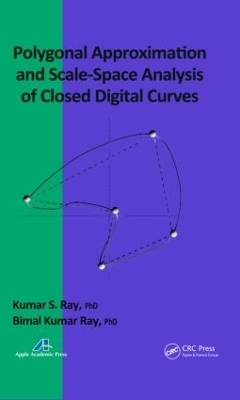
Polygonal Approximation and Scale-Space Analysis of Closed Digital Curves
Apple Academic Press Inc. (Verlag)
978-1-926895-33-8 (ISBN)
Kumar S. Ray, PhD, is a professor in the Electronics and Communication Science Unit at the Indian Statistical Institute, Kolkata, India. He has written a number of articles published in international journals and has presented at several professional meetings. His current research interests include artificial intelligence, computer vision, commonsense reasoning, soft computing, non-monotonic deductive database systems, and DNA computing. Bimal Kumar Ray is a professor at the School of Information Technology and Engineering, Vellore Institute of Technology, Vellore, India. He received his PhD degree in computer science from the Indian Statistical Institute, Kolkata, India. He received hs master’s degree in applied mathematics from Calcutta University and his bachelor’s degree in mathematics from St. Xavier’s College, Kolkata. His research interests include computer graphics, computer vision, and image processing. He has published a number of research papers in peer-reviewed journals.
Polygonal Approximation: Introduction. A Split-and-Merge Technique. A Sequential One-Pass Method. Another Sequential One-Pass Method. A Data-Driven Method. Another Data-Driven Method. A Two-Pass Sequential Method. Polygonal Approximation Using Reverse Engineering on Bresenham's Line Drawing Technique. Polygonal Approximation as Angle Detection. Polygonal Approximation as Angle Detection Using Asymmetric Region of Support. Scale-space analysis: Introduction. Scale-Space Analysis and Corner Detection on Chain Coded Curves. Scale-Space Analysis and Corner Detection Using Iterative Gaussian Smoothing With Constant Window Size. Corner detection using Bessel function as smoothing kernel. Adaptive smoothing using convolution with Gaussian Kernel. Application of Polygonal Approximation for Pattern Classification and Object Recognition: Introduction. Polygonal Dissimilarity and Scale Preserving Smoothing
Matching Polygon Fragments. Polygonal Approximation to Recognize and Locate Partially Occluded Objects: Hypothesis Generation and Verification Paradigm. Object Recognition With Belief Revision: Hypothesis Generation and Belief Revision Paradigm. Neuro-Fuzzy Reasoning for Occluded Object Recognition: A Learning Paradigm Through Neuro-Fuzzy Concept. Conclusion.
| Zusatzinfo | 153 Illustrations, black and white |
|---|---|
| Verlagsort | Oakville |
| Sprache | englisch |
| Maße | 156 x 234 mm |
| Gewicht | 703 g |
| Themenwelt | Mathematik / Informatik ► Informatik ► Software Entwicklung |
| Informatik ► Theorie / Studium ► Algorithmen | |
| ISBN-10 | 1-926895-33-9 / 1926895339 |
| ISBN-13 | 978-1-926895-33-8 / 9781926895338 |
| Zustand | Neuware |
| Haben Sie eine Frage zum Produkt? |
aus dem Bereich


